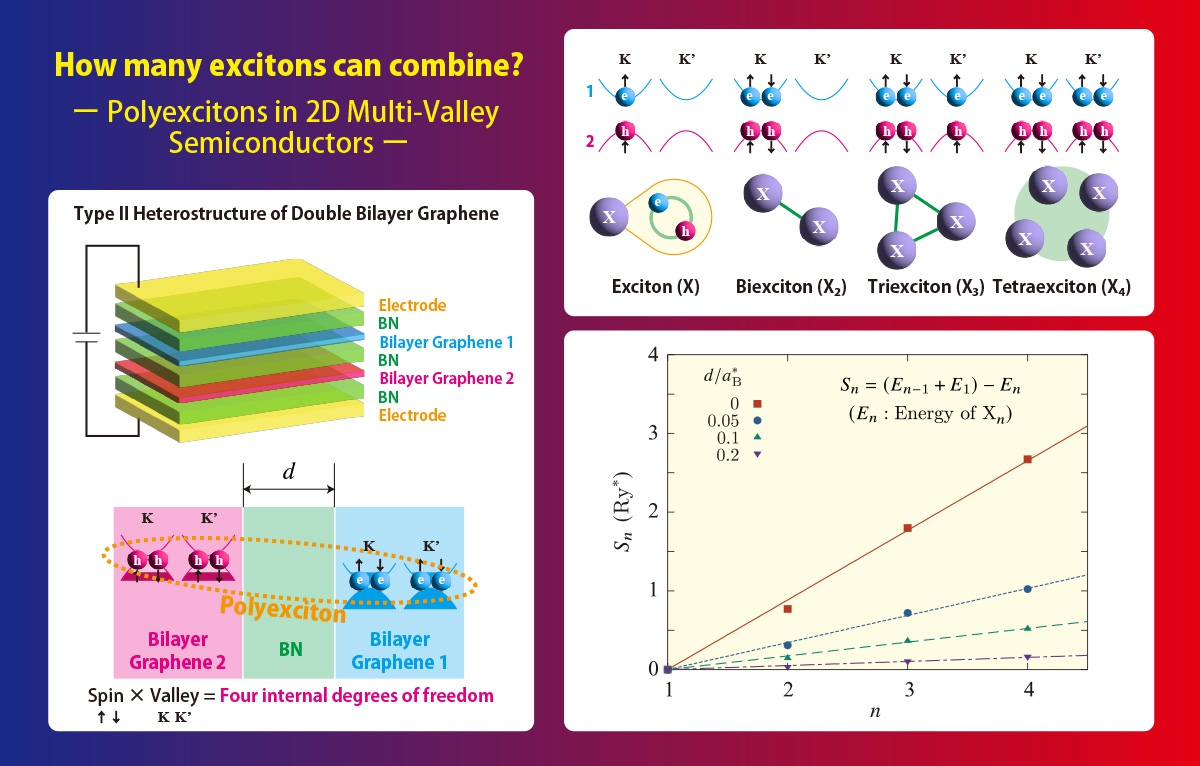How Many Excitons Can Combine?
© The Physical Society of Japan
This article is on
Polyexcitons in Two Dimensions
(JPSJ Editors' Choice)
J. Phys. Soc. Jpn.
92,
073702
(2023)
.
Quantum diffusion Monte Carlo simulation demonstrated the formation of polyexcitons in two-dimensional multi-valley semiconductor systems, where all exciton pairs were energetically bound by equal-strength “chemical bonds.”

Polyexcitons are composites of multiple electron-hole pairs. In strongly photoexcited intrinsic semiconductors or type II semiconductor heterostructures, an electron in conduction bands and a hole in valence bands naturally form an exciton, and further, a pair of excitons coalesces into a biexciton. These composites have been studied in an analogy to hydrogen atoms or molecules. A common expectation is that excitons cannot form triexcitons, similar to hydrogen atoms that cannot form trimers. However, in multi-valley semiconductors, more than two excitons can be bound, because electrons and holes acquire the additional valley degrees of freedom that, combined with the spins, allow more than two electrons and holes to occupy the same position. This possibility was first identified by Wang and Kittel in 1972 and has been experimentally observed in pure bulk samples of silicon and diamond as the photoluminescence (PL) peaks almost equally spaced at energy intervals.
We consider the two-dimensional simplified model of the type II double-bilayer graphene heterostructures. The electrons and holes stay on different layers separated by a distance and interact with each other via Coulomb potentials. They also acquire four internal degrees of freedom because they have two spin and two valley degrees of freedom. This implies that our system can afford triexcitons and tetraexcitons, and that the quantum diffusion Monte Carlo simulation is free of the negative sign problem and can precisely evaluate the energies.
Notably, the separation energy required to pull out one exciton from the polyexciton grows almost exactly linearly with the exciton number. This behavior resembles the aforementioned PL peaks, indicating that the underlying physics is common between two and three dimensions. This further implies that all pairs of excitons inside the polyexciton are energetically bound by “chemical bonds” of equal strength, irrespective of the bound exciton numbers or the details of the system, for example, the interlayer distances.
(Written by K. Asano on behalf of all the authors)
"Polyexcitons in Two Dimensions
(JPSJ Editors' Choice)
J. Phys. Soc. Jpn.
92,
073702
(2023)
.
Share this topic
Fields
Related Articles
-
Higher-Order Topological Phases in Magnetic Materials with Breathing Pyrochlore Structures
Electronic structure and electrical properties of surfaces and nanostructures
Magnetic properties in condensed matter
Mathematical methods, classical and quantum physics, relativity, gravitation, numerical simulation, computational modeling
2025-4-7
A simple example of a higher-order topological phase, in which the symmetry decreases step-by-step from the bulk to the corner, is realized in a magnetic system with a pyrochlore structure and is characterized by a series of quantized Berry phases defined for the bulk, surface, and edge.
-
Shaping the Future of Materials Science with Tanabe–Sugano Diagrams
Dielectric, optical, and other properties in condensed matter
Electron states in condensed matter
Electronic structure and electrical properties of surfaces and nanostructures
Magnetic properties in condensed matter
2025-1-21
This special collection published in the Journal of the Physical Society of Japan celebrates 70 Years of Tanabe–Sugano Diagrams, highlighting their continued role in advancing materials with transition metals.
-
How to Construct a 3D Dirac Semimetal by Stacking 2D Massless Dirac Fermion Layers
Electron states in condensed matter
Electronic structure and electrical properties of surfaces and nanostructures
2025-1-14
Interlayer spin–orbit coupling originating from the anion potential gives rise to a 3D Dirac semimetal state that preserves inversion symmetry in the multilayer organic massless Dirac fermion system α-(ET)2I3.
-
Unlocking Secrets of Novel Charge-Orbital States in Transition-Metal Compounds
Cross-disciplinary physics and related areas of science and technology
Electron states in condensed matter
Electronic structure and electrical properties of surfaces and nanostructures
Magnetic properties in condensed matter
Structure and mechanical and thermal properties in condensed matter
2025-1-6
A new Special Topics edition of the Journal of the Physical Society of Japan features articles exploring special transition-metal compounds that exhibit novel charge-orbital states.
-
The Stiffness of Electronic Nematicity
Dielectric, optical, and other properties in condensed matter
Electronic structure and electrical properties of surfaces and nanostructures
Electronic transport in condensed matter
2024-11-21
Using laser-excited photoelectron emission microscope (laser-PEEM) we found that the nematic stiffness in iron-based superconductors significantly increases as the systems become strange metals, suggesting that spin–orbital fluctuations enhance the stiffness of electronic nematicity.




